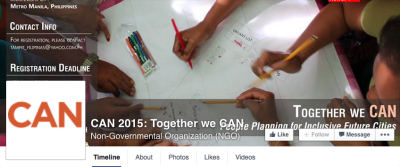- Home
- About us
- Activities
-
About us
- News & Update
- Library
- Countries
- extra
- contact
activities
Click Show/hide
CAN - Community Architects Nework

March 2013: The network now brings together 27 groups in 17 Asian countries, who use the network as a platform to link with each other, share ideas, learn from each other's work and help make it stronger. These groups include architects, engineers, designers, community-based builders and professors and students from universities. All of them are deeply involved in working on the ground to support communities in several ways: community mapping, settlement upgrading, comprehensive site-planning, housing design, community-builders training, exploration of alternative and cost-saving local building materials, engaging with universities and academics and sharing knowledge through meetings, workshops, print and electronic media.
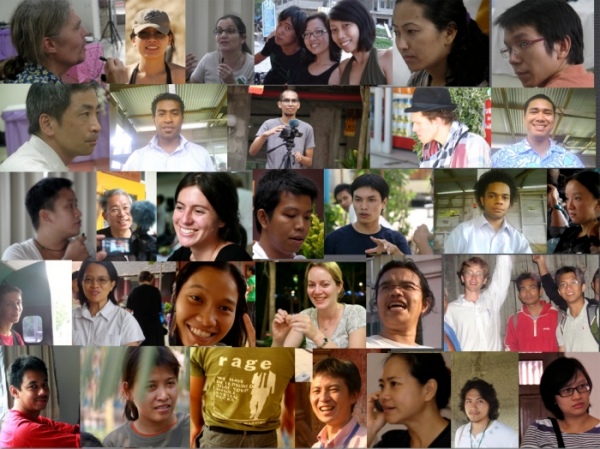
In the first 2 -3 years we have focused our work on four activities to support, strengthen and expand this community architecture movement in Asia.
Building groups of local architects to work with people, in each country.
Many countries don’t have groups of local community architects to work with the communities yet. So in some countries, we have assisted by organising pilot community-upgrading and housing design workshops that are tied to actual projects, with support from the local NGOs (in Nepal, Lao PDR, Myanmar, Fiji and Penang). An important part of these projects is linking with faculties of architecture and young professional people in that place, and inviting them to participate in these projects and to learn how to work with communities. After that, we try to support the young people to keep working with the communities.
Organising training seminars and lectures
In several countries, we have given lectures at architecture faculties (in Vietnam, Mongolia, Lao PDR) and organized hands-on training seminars with students, young professionals and community people about how to work with communities, to support a community-driven housing design process (in Lao PDR, Cambodia, Myanmar, Nepal, Fiji and the Philippines). This is not just to develop technical support skills, but to show these young people how to make communities become the designers and technicians of a design process which belongs to people (community design workshops in Vientiane, Phnom Penh and Yangon; earth-block making workshops in Vinh, Phnom Penh and Ulaanbaatar; a community mapping workshop in Fiji, a bamboo construction workshop in Davao and a slum-upgrading architectural competition in Surabaya. We’re now planning a big regional mapping workshop in Karachi.).
Building a regional network of community architects in Asia
to share their experiences, share their knowledge and assist each other in different ways. In June 2010, we organized a 5-day regional gathering of 100 community architects and community builders in Chiang Mai, which gave a chance for all these groups to meet, present their work, compare notes and begin to set joint plans as a regional network of community architects. (Full transcripts of the interesting presentations at this meeting can be downloaded from the ACHR website.) Many of these groups also travel to join in the design workshops and training seminars in other countries. One of the first activities of this new regional network (which was officially inaugurated in Chiang Mai) has been to support fledgling community architect groups in each country with small seed funds of $5,000 per country. So far, community architecture groups in nine countries have received this support and are using it in a variety or ways to initiate pilot projects with communities or to build their own national community architects networks. In some countries, these groups already existed (as in the Philippines, Cambodia, Pakistan, Indonesia and Vietnam) and in some countries they are just getting started (as in Lao PDR, Myanmar, Fiji and Mongolia). These groups can include young architects, architecture students and professors, engineers, planners and community builders.
Sharing experiences
We are also working to document the work of community architects around Asia and to help disseminate their stories, experiences and ideas through various media, including publications (a book on community architecture work by key groups around the region and a series of handbooks on mapping and community planning have already been published, and another handbook on the poor in heritage cities is now in process), documentary films about the work of community architects, and the setting up of a regional community architects blog / website.
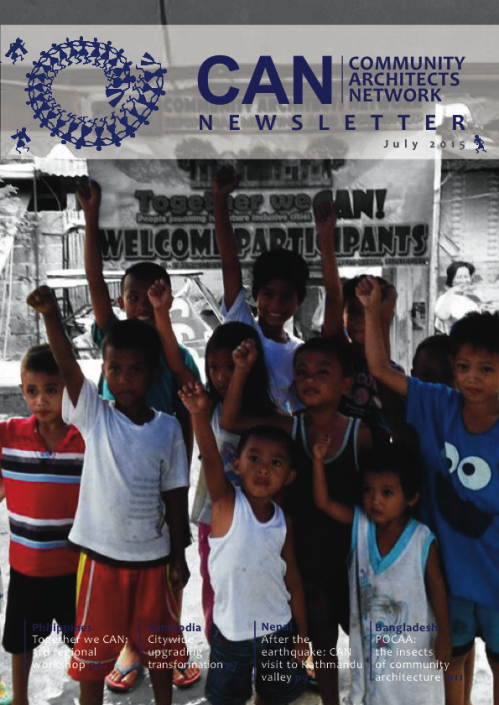
Community Architects Network - Asia
CAN NEWSLETTER No. 4 - Posted Sept 2015
Size: 12452 MB
In June the Philippines hosted the 3rd CAN Regional workshop for the second edition in a row. Thank-you to all the Philippines Alliance for taking on the task of organising it and doing it
so well! This year, beyond participants from the CAN network in Asian countries, for the first time the workshop was open to “outsiders”, as a way to broaden the network. Participants from Nepal unfortunately weren’t present, as they are still very busy responding to the earthquake - covered in this issue - but we were lucky, our friend network Slum Dwellers International were able to attend all the way from South Africa.
In May, CANCAM in Cambodia organised another international workshop together with the Development Planning Unit from London, demonstrating an incredible growth in terms of capacity. CAN is growing, evolving and maturing. At the latest Core Team meeting in the Philippines following the regional workshop, we talked a lot about how to restructure the network for the future to achieve more decentralisation and self-sustainability.
In parallel, CAN is being recognised more and more as an international platform with a unique approach providing a much needed contribution to development work. The Buckminster Fuller Institute selected CAN as one of the 14 finalists among more than 400 applicants to their annual award based on such criteria as “Visionary, Comprehensive, Anticipatory, Ecologically Responsible, Verifiable, Feasible, and Replicable”.on such criteria as “Visionary, Comprehensive, Anticipatory, Ecologically Responsible,
DOWNLOAD from the CAN site HERE 12 Mb
http://communityarchitectsnetwork.info/openSource_publication.php?ic=3
CAN NEWSLETTER No. 4 - Posted Sept 2015
Size: 12452 MB
In June the Philippines hosted the 3rd CAN Regional workshop for the second edition in a row. Thank-you to all the Philippines Alliance for taking on the task of organising it and doing it
so well! This year, beyond participants from the CAN network in Asian countries, for the first time the workshop was open to “outsiders”, as a way to broaden the network. Participants from Nepal unfortunately weren’t present, as they are still very busy responding to the earthquake - covered in this issue - but we were lucky, our friend network Slum Dwellers International were able to attend all the way from South Africa.
In May, CANCAM in Cambodia organised another international workshop together with the Development Planning Unit from London, demonstrating an incredible growth in terms of capacity. CAN is growing, evolving and maturing. At the latest Core Team meeting in the Philippines following the regional workshop, we talked a lot about how to restructure the network for the future to achieve more decentralisation and self-sustainability.
In parallel, CAN is being recognised more and more as an international platform with a unique approach providing a much needed contribution to development work. The Buckminster Fuller Institute selected CAN as one of the 14 finalists among more than 400 applicants to their annual award based on such criteria as “Visionary, Comprehensive, Anticipatory, Ecologically Responsible, Verifiable, Feasible, and Replicable”.on such criteria as “Visionary, Comprehensive, Anticipatory, Ecologically Responsible,
DOWNLOAD from the CAN site HERE 12 Mb
http://communityarchitectsnetwork.info/openSource_publication.php?ic=3
JULY Update:
Follow the CAN Regional Workshop impacts in the Philippines at the new Face Book page HERE
Follow the CAN Regional Workshop impacts in the Philippines at the new Face Book page HERE
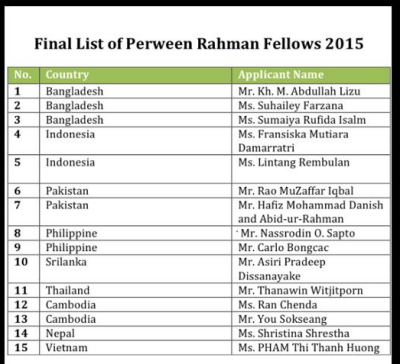
CAN UPDATE JUNE 2015
Congratulation to the 15 fellows of 2015.
From Francesco, Nad, Tee and Ariel!
First of all we feel very thankful for your ambitious and heart-felt efforts reflected in your work and proposals.
It appear to us that across the region there are many architect/planner/engineer/community builders who are working to change our society to be more equal, lively, and with a sense of beauty.
This is the way to commemorate and continue the spirit of Perween Rahman and many good people who came before us.
Here we would like to officially announce the result of Perween Rahman Fellowship 2015. More news on the winning projects soon.
Congratulation to the 15 fellows of 2015.
From Francesco, Nad, Tee and Ariel!
First of all we feel very thankful for your ambitious and heart-felt efforts reflected in your work and proposals.
It appear to us that across the region there are many architect/planner/engineer/community builders who are working to change our society to be more equal, lively, and with a sense of beauty.
This is the way to commemorate and continue the spirit of Perween Rahman and many good people who came before us.
Here we would like to officially announce the result of Perween Rahman Fellowship 2015. More news on the winning projects soon.

APRIL 2015
CAN NEWSLETTER APRIL 2015
CAN NEWSLETTER APRIL 2015
Size: 8370 MB
Craftsmanship in architecture
We have come to the third issue of the CAN newsletter. Without intentionally creating a theme, unexpectedly a large number of stories arrived sharing on the role of craftsmanship in architecture at the scale of the household, and also the city. A week-long heritage conservation workshop hosted by friendsin Kathmandu, and a heritage tour launched by friends in Yogyakarta, both place the artisans themselves as the main actors in the upgrading process producing a form of “living heritage”. Young professional supported by the Perween Rahman Fellowship in Vietnam experiment with using compressed soil bricks as a low-cost alternative to concrete, while our friends from Hunnarshala, India share on their recent progress with rammed earth construction, and a new housing project for the homeless in Bangkok gives the space for residents to be the artisans of their own unit. The Siamese Association of architects has also decided to dedicate a public seminar to artisan-architects working, designing, and building with bamboo, rammed earth, and wood.
Hope you enjoy reading this collection of inspiring stories, please share with others, and please shareother stories with us. DOWNLODD HERE
We have come to the third issue of the CAN newsletter. Without intentionally creating a theme, unexpectedly a large number of stories arrived sharing on the role of craftsmanship in architecture at the scale of the household, and also the city. A week-long heritage conservation workshop hosted by friendsin Kathmandu, and a heritage tour launched by friends in Yogyakarta, both place the artisans themselves as the main actors in the upgrading process producing a form of “living heritage”. Young professional supported by the Perween Rahman Fellowship in Vietnam experiment with using compressed soil bricks as a low-cost alternative to concrete, while our friends from Hunnarshala, India share on their recent progress with rammed earth construction, and a new housing project for the homeless in Bangkok gives the space for residents to be the artisans of their own unit. The Siamese Association of architects has also decided to dedicate a public seminar to artisan-architects working, designing, and building with bamboo, rammed earth, and wood.
Hope you enjoy reading this collection of inspiring stories, please share with others, and please shareother stories with us. DOWNLODD HERE
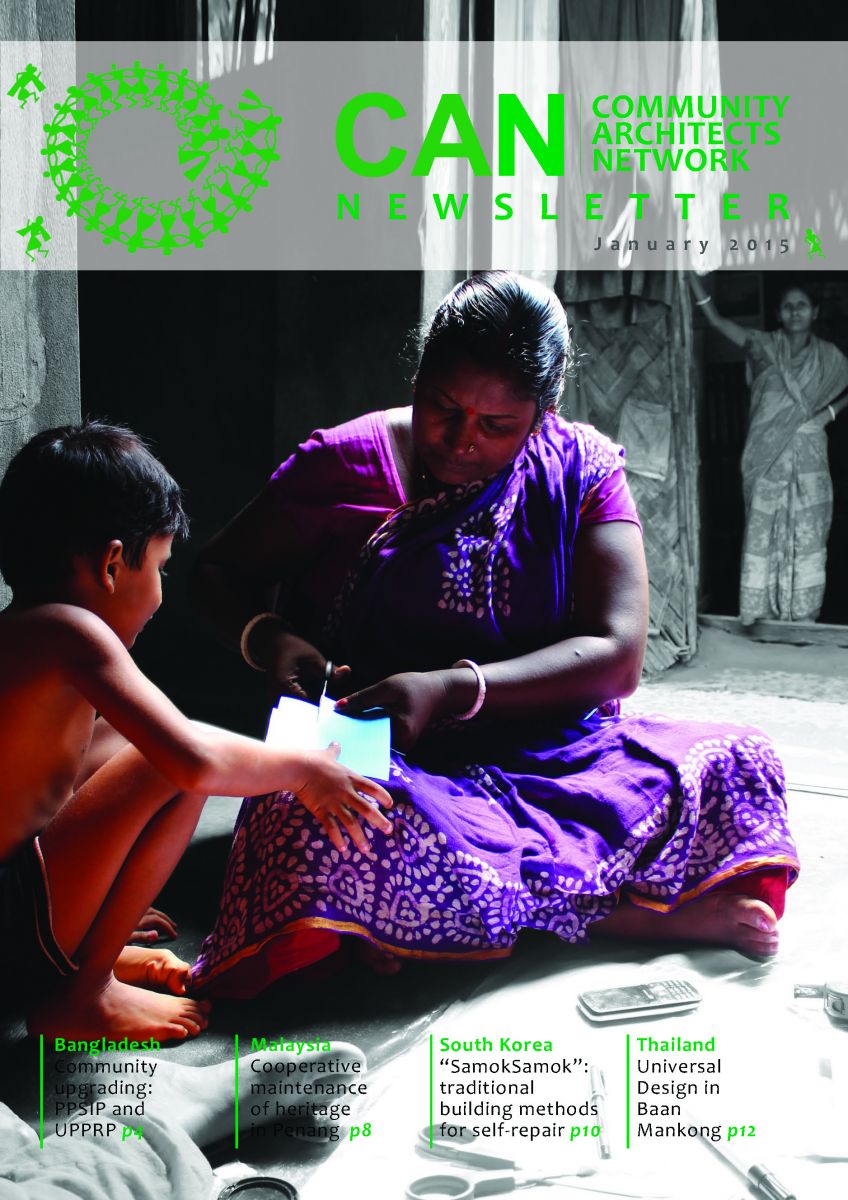
CAN NEWSLETTER No. 2 AVAILABLE for Download from the CAN site:
Size: 9015 MB
This 2nd edition of the CAN newsletter starts with a special feature on Bangladesh, a country with a huge population and housing problem where the community architecture approach is still young but growing fast. Two big projects are now underwayin the country, seeking to apply the principles of participatory upgrading across Bangladesh’s lowincome communities. We also have some good examples of people and communities taking on an active role in maintaing and renovating their own houses, buildings and architectural and cultural heritage, in such different contexts as UNESCO heritage site George Town, the metropolis of Seoul, and the mountain city of Leh in Ladakh. From Thailand, we received a piece on how to apply‘universal design’ for people’s needs into community upgrading, and a beautiful story on land planning reform from the bottom up in the hilly Mae Tha district.
We are launching our new section ‘Beyond CAN’ to hear inspiring stories of change from other parts of the world, with two stories from Chile, where progressive government policies and innovative young architects are changing the way cities are made. We hope you’ll enjoy reading these stories and we strongly invite everyone to contribute to the newsletter, to help make it become a space for exchange and learning across the network and beyond.
Go HERE to Download from the CAN Web site
We are launching our new section ‘Beyond CAN’ to hear inspiring stories of change from other parts of the world, with two stories from Chile, where progressive government policies and innovative young architects are changing the way cities are made. We hope you’ll enjoy reading these stories and we strongly invite everyone to contribute to the newsletter, to help make it become a space for exchange and learning across the network and beyond.
Go HERE to Download from the CAN Web site
THE ROLE OF COMMUNITY ARCHITECTS IN UPGRADING; REFLECTING ON THE EXPERIENCE IN ASIA: CHAWANAD LUANSANG, SUPAWUT BOONMAHATHANAKORN AND MARIA LOURDES DOMINGO-PRICE
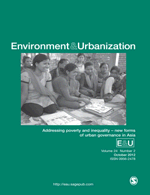
This paper describes the role of community architects in the upgrading programmes supported by the Asian Coalition for Community Action (ACCA), illustrated with examples that include a bamboo bridge project in Davao and a toilet project in Digos (the Philippines), a community-driven land allocation system in Gopalganj (Bangladesh), and upgrading developed by a savings group in a landless community in Hlaing Tar Yar township (Myanmar). Drawing on the authors’ experiences working as community architects, it also reflects on how to integrate social and physical change in communities in order to effect broader changes in society. The paper discusses the merits of community architecture and identifies what makes a good community architect, and describes the Community Architects Network (CAN) that has been formed and how it encourages architectural schools to incorporate knowledge and experience from community architects into their curriculum.
 1.5. Mbs 2012
1.5. Mbs 2012
 1.5. Mbs 2012
1.5. Mbs 2012CAN UPDATES
Sept 2015: 3rd CAN Regional Workshop -
The third CAN Regional Workshop and Meeting; Together We CAN! People planning for future inclusive cities took place in June in Metro Manila, Philippines. It focused on two areas, Muntinlupa City (barangays: Sucat, Buli, Alabang) and Intramuros (Manila), with which the Philippine Alliance had been actively working.
 3 Page Extract from the 4th CAN Newsletter July 2015 includes plans for the coming year.
3 Page Extract from the 4th CAN Newsletter July 2015 includes plans for the coming year.
 3 Page Extract from the 4th CAN Newsletter July 2015 includes plans for the coming year.
3 Page Extract from the 4th CAN Newsletter July 2015 includes plans for the coming year.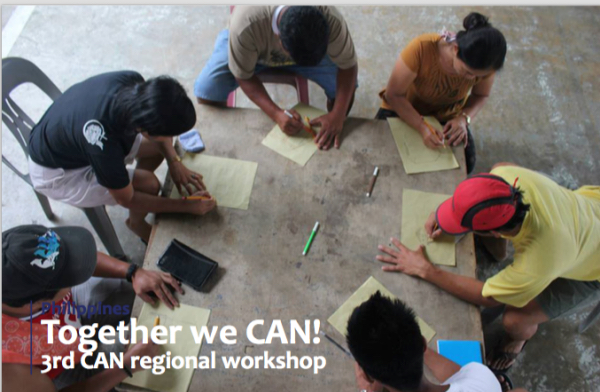
February 2015
New Applications Form for the Perween Rahman Fellowships:
New Application Form DOWNLOAD HERE
More News and Detail about the 2015 Felowships ( 2 page Word doc 2.3 mbs from CAN Feb. 2015)

October 2014 More detail of the Fellowship previous winners and their projects

Extract from CAN Newsletter Oct 2014 410 KB
March 2014 Announcment:
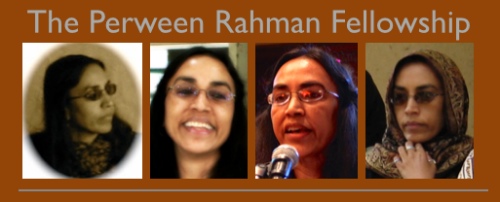 WHY THE FELLOWSHIP?
WHY THE FELLOWSHIP? Since Perween’s death in March 2013, her colleagues in Pakistan have begun projects to commemorate Perween’s work in several ways. The Perween Rahman fellowship is a way her friends in the ACHR network mean to keep alive the extraordinary spirit and innovation of her work. Perween was above all a consummate community architect, and the fellowship is being launched to nurture a new generation of community architects to follow her example of working closely with poor communities, as equals, and of merging the professional with the people, to create a new kind of community planning and construction process that makes big change in the lives of the poor.
2014 Fellowship Awards to ......
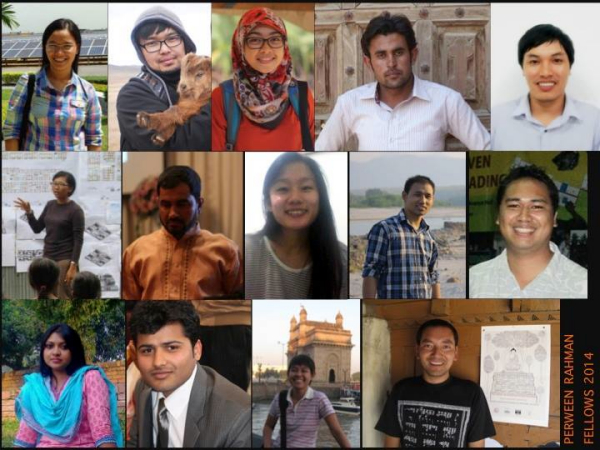
Follow the projects on a special and very active Facebook page HERE
In this Update read news-briefs on CAN activities from JUNE to AUGUST 2012
CAN workshop in Ahmedabad; and the following workshop in Bhuj, India for Community Builders. CAN were represented in Italy at the World Urban Forum. and produced a new book for the event. Later in August young architects from CAN went to Nepal and held a workshop with Kathmandu’s riverside communities who are under threat of eviction.
 Extract from ACHR E-News Oct 2012
Extract from ACHR E-News Oct 2012The first important principle of a Community Architect is the one who sees PEOPLE, who works with PEOPLE, who sees there wisdom, who sees their solutions, and who builds his solutions on PEOPLES” solutions, who respects traditions, culture, peoples’ skills, and peoples’ knowledge, desires and frustrations, and believes in and practices participatory methods. Who is committed to low cost and appropriate technology and local wisdom and context, where LOCAL is really important, whose creative struggle is confined not so much to inventing new forms and designing daring and bold structures, but doing MORE with LESS and seeing BIG in SMALL. They work together and togetherness is their ethos, synergies is their mantra.
Kirtee Shah Indian Architect…
"The energy of the young, their maturity and subject strength, richness of ideas, environment of togetherness and belonging, spirit of sharing, scale (27 countries !), variety and promise - all that was stunning and inspiring to me. It is working! It made me feel young again! "
... Kirtee Shah .... at the CAN international workshop to launch the network
ACHR will continue to publish CAN news and updates on this page, however for more information you can go to the CAN WEBSITE HERE
ACHR will continue to publish CAN news and updates on this page, however for more information you can go to the CAN WEBSITE HERE
CAN Library - Publications
CAN have pblished 5 BOOKS on experiences with Community Archetecture
BANG BUA CANAL UPGRADING GUIDEBOOK
COMMUNITY MAPPING HAND BOOK 1
COMPREHENSIVE SITE PLANNING HAND BOOK 2
DESIGN WITH PEOPLE BOOK
HANDBOOK FOR COMMUNITY ARCHITECTS
READ MORE on each Here and DOWNLOAD if you wish.
CAN have also produced a number of VIDEOS
COMMUNITY MAPPING
THE COMMUNITY ARCHITECTS NETWORK (CAN)
WOMEN SAVING GROUP, MYANMAR
PERWEEN RAHMAN LAST PRESENTATION AT AN ACHR REGIONAL MEETING IN BANGKOK JANUARY 2013
COMMUNITY BUILT BAMBOO FOOTBRIDGE - SHORT (2012)
You can read about them and or watch them HERE
And more information available on the CAN website HERE
BANG BUA CANAL UPGRADING GUIDEBOOK
COMMUNITY MAPPING HAND BOOK 1
COMPREHENSIVE SITE PLANNING HAND BOOK 2
DESIGN WITH PEOPLE BOOK
HANDBOOK FOR COMMUNITY ARCHITECTS
READ MORE on each Here and DOWNLOAD if you wish.
CAN have also produced a number of VIDEOS
COMMUNITY MAPPING
THE COMMUNITY ARCHITECTS NETWORK (CAN)
WOMEN SAVING GROUP, MYANMAR
PERWEEN RAHMAN LAST PRESENTATION AT AN ACHR REGIONAL MEETING IN BANGKOK JANUARY 2013
COMMUNITY BUILT BAMBOO FOOTBRIDGE - SHORT (2012)
TIBETAN HERITAGE PRESERVATION THF LHASA
LIVING WITH DISASTERS: MERAPI DUWE GAWE
LIVING WITH DISASTERS: MERAPI DUWE GAWE
And more information available on the CAN website HERE

